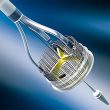A recent presentation at London Valves took a closer look at the REPRISE III trial as regards two points that generated much discussion, such as need for a pacemaker and paravalvular leak. REPRISE III had previously demonstrated that the Lotus is noninferior to first-generation CoreValve and Evolut R in terms of safety. Additionally, it proved to be superior...
End of Discussion on the Impact of Pacemaker After TAVR?
Transcatheter aortic valve replacement (TAVR) is often associated with conduction abnormalities, which usually end with permanent pacemaker (PPM) implantation in 10-40% of patients. Factors predisposing to PPM after TAVR have been studied in great detail, but their short- and long-term clinical impact is still controversial. Recently, outcomes from a large cohort of patients were...
Lotus Valve performance related to pacemaker implantation in patients after TAVR
Courtesy of Dr. Agustín Vecchia. Paravalvular leak was once considered the greatest disadvantage of TAVR when compared to conventional surgery. Nowadays, new devices and more-experienced operators have managed to “control” this phenomenon, keeping related statistics within acceptable ranges. Repositionable-valve Lotus may probably offer the most effective solution for this event; however, it is associated with high rates of...
Transcatheter valve replacement in the bicuspid valve is increasingly performed, but challenges remain
As experience increases, transcatheter aortic valve replacement (TAVR) has expanded to different populations and anatomies. This study sought to compare technical and clinical outcomes in patients with bicuspid versus tricuspid aortic stenosis from the Bicuspid AS TAVR Multicenter Registry. Outcomes of 561 patients with bicuspid valves and 4546 patients with tricuspid valves were compared. Propensity score matching was used...
TAVR presents less post-procedural MI than surgical aortic valve replacement
Courtesy of Dr. Carlos Fava. Surgical aortic valve replacement (SAVR) continues to be elective, but the presence of post-procedural acute myocardial infarction (AMI) has been associated to bad evolution. Despite the proven benefits of TAVR for high risk patients and the progress shown by patients of intermediate risk, the incidence of post implantation MI has...
[SURTAVI] Sub-study of neurological events: more evidence in favor of TAVR
Courtesy of SBHCI. The occurrence of a periprocedural neurological events is associated to an increased risk of death and morbidity at long term, both for transcatheter aortic valve replacement (TAVR) and for surgery. The SURTAVI study, recently presented at the ACC meeting and simultaneously published by NEJM, showed that TAVR with self-expandable CoreValve or Evolut...
NOTION: TAVI with low risk at 4 year follow up
Courtesy of the SBHCI. There is little data about the use of transcatheter aortic valve replacement (TAVR) to treat patients with severe aortic stenosis at low surgical risk. Many of the questions involve long term duration of valves (over 10 years) when treating younger patients with longer life expectancy. The NOTION study aims at comparing...
VIVA Post-Market Study: More Evidence for the Valve-in-Valve Technique
Courtesy of the SBHCI. Bioprosthetic surgically-implanted valves degenerate over time, while patients become too old and are at high risk for reoperation. Transcatheter aortic valve implantation inside a deteriorated surgically-implanted valve (a valve-in-valve procedure) is an emerging alternative. The VIVA trial was designed to offer systematic and prospective data from patients treated with...
Bicuspid Aortic Valve Stenosis Still Challenging for TAVR
Courtesy of Dr. Carlos Fava One of the present challenges of TAVR is bicuspid aortic valve stenosis (AS), since it presents a different distribution and structure, associated to greater and more irregular calcification. There are only small series of devices and their use is still controversial. The study analyzed 561 patients with severe bicuspid...
Surgery or TAVR in intermediate risk? Results of the SURTAVI Study
Courtesy of Dr. Gustavo Leiva. Transcatheter aortic-valve replacement (TAVR) with the use of a self-expanding prosthesis is superior to medical therapy in patients with severe, symptomatic aortic stenosis in whom surgical aortic-valve replacement has been associated with prohibitive risk. Among patients considered at high risk, TAVR may be an alternative to surgery. The comparative...









